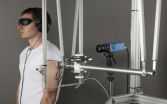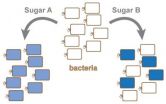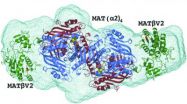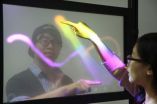(Press-News.org) Overturning conventional wisdom stretching all the way to Leonardo da Vinci, new Hebrew University of Jerusalem research shows that how things break (fracture) and how things slide (friction) are closely interrelated. The breakthrough study marks an important advance in understanding friction and fracture, with implications for describing the mechanics that drive earthquakes.
Over 500 years ago, da Vinci described how rough blocks slide over one another, providing the basis for our understanding of friction to this day. The phenomenon of fracture was always considered to be something totally different.
But new research by Prof. Jay Fineberg and his graduate student Ilya Svetlizky, at the Hebrew University's Racah Institute of Physics, has demonstrated that these two seemingly disparate processes of fracture and friction are actually intimately intertwined.
Appearing in the journal Nature, their findings create a new paradigm that's very different from the da Vinci version, and, according to the researchers, give us a new understanding of how earthquakes actually occur.
Fineberg and Svetlizky produced "laboratory earthquakes" showing that the friction caused by the sliding of two contacting blocks can only occur when the connections between the surfaces are first ruptured (that is, fractured or broken) in an orderly, "organized" process that takes place at nearly the speed of sound.
How does this happen? Before any motion can occur, the blocks are connected by interlocking rough contacts that define their interface. In order for motion to occur, these connections have to be broken. This physical process of breaking is called a fracture process. This process is described by the theory of crack propagation, say the researchers, meaning that the stresses (or forces) that exist at the front edge of a crack become highly magnified, even if the overall forces being applied are initially quite small.
"The insights gained from our study provide a new paradigm for understanding friction and give us a new, fundamental description of the mechanics and behavior that drive earthquakes, the sliding of two tectonic blocks within natural faults," says Fineberg. "In this way, we can now understand important processes that are generally hidden kilometers beneath the earth's surface."
INFORMATION:
The research paper, "Classical shear cracks drive the onset of dry frictional motion," appeared in the journal Nature (online at http://bit.ly/1mlDa1C). A "News & Views" review of the research can be seen in Nature Physics at http://bit.ly/1jVOXQh.
The research was supported by the James S. McDonnell Fund, the European Research Council (grant no. 267256) and the Israel Science Foundation (grant 76/11).
Earthquakes explained? New research shows friction and fracture are closely related
Was da Vinci wrong? New paradign overturns conventional wisdom
2014-07-08
ELSE PRESS RELEASES FROM THIS DATE:
Contradictory findings about the effect of the full moon on sleep
2014-07-08
A Swiss research study conducted last year showed that the full moon affects sleep. The findings demonstrated that people average 20 minutes less sleep, take five minutes longer to fall asleep and experience 30 minutes more of REM sleep, during which most dreaming is believed to occur.
Different outcome
Numerous studies through the years have attempted to prove or disprove the hypothesis that lunar phases affect human sleep. But results have been hard to repeat. A group of researchers at the famed Max Planck Institute and elsewhere analyzed data from more than 1,000 ...
Collisions with robots -- without risk of injury
2014-07-08
Everybody has experienced this: You aren't careful for just one moment and suddenly you run into the edge of a table. At first, it hurts. A little later, a bruise starts to appear. What falls into the category of "nothing bad, but aggravating" in the case of a table, takes on a new dimension when the colliding partner is a robot, because such a collision can injure humans seriously. That is why these mechanical assistants usually still work behind protective barriers. Since some applications require humans and robots to work hand-in-hand, though, their cooperation has become ...
Preterm babies more likely to survive in larger newborn care units
2014-07-08
Premature newborns are 32% less likely to die if they are admitted to high volume neonatal units rather than low volume, according to new research.
The study, led by the University of Warwick and published in BMJ Open, analysed data from 165 neonatal units across the UK. It found babies born at less than 33 weeks gestation were 32% less likely to die if they were admitted to high volume units, compared to low volume.
For babies born at less than 27 weeks the effect was greater, with the odds of dying almost halved when they were admitted to high volume units, compared ...
New research finds working memory is the key to early academic achievement
2014-07-08
Working memory in children is linked strongly to reading and academic achievement, a new study from the University of Luxembourg and partner Universities from Brazil* has shown. Moreover, this finding holds true regardless of socio-economic status. This suggests that children with learning difficulties might benefit from teaching methods that prevent working memory overload. The study was published recently in the scientific journal "Frontiers in Psychology".
The study was conducted in Brazil on 106 children between 6 and 8 from a range of social backgrounds, with half ...
Sandalwood scent facilitates wound healing and skin regeneration
2014-07-08
Skin cells possess an olfactory receptor for sandalwood scent, as researchers at the Ruhr-Universität Bochum have discovered. Their data indicate that the cell proliferation increases and wound healing improves if those receptors are activated. This mechanism constitutes a possible starting point for new drugs and cosmetics. The team headed by Dr Daniela Busse and Prof Dr Dr Dr med habil Hanns Hatt from the Department for Cellphysiology published their report in the "Journal of Investigative Dermatology".
The nose is not the only place where olfactory receptors occur
Humans ...
Treatment-resistant hypertension requires proper diagnosis
2014-07-08
High blood pressure—also known as hypertension—is widespread, but treatment often fails. One in five people with hypertension does not respond to therapy. This is frequently due to inadequate diagnosis, as Franz Weber and Manfred Anlauf point out in the current issue of Deutsches Ärzteblatt International (Dtsch Arztebl Int 2014; 111: 425–31).
If a patient's blood pressure is not controlled by treatment, this can be due to a number of reasons. Often it is the medication the patient is on. Some patients may be taking other medicines – in addition to their antihypertensive ...
When faced with some sugars, bacteria can be picky eaters
2014-07-08
Researchers from North Carolina State University and the University of Minnesota have found for the first time that genetically identical strains of bacteria can respond very differently to the presence of sugars and other organic molecules in the environment, with some individual bacteria devouring the sugars and others ignoring it.
"This highlights the complexity of bacterial behaviors and their response to environmental conditions, and how much we still need to learn," says Dr. Chase Beisel, an assistant professor of chemical and biomolecular engineering at NC State ...
A possible pathway for inhibiting liver and colon cancer is found
2014-07-08
A group of scientists from Spain, the UK and the United States has revealed the structure of a protein complex involved in liver and colon cancers. Both of these types of cancer are of significant social and clinical relevance as in 2012 alone, liver cancer was responsible for the second highest mortality rate worldwide, with colon cancer appearing third in the list.
The international team from CIC bioGUNE, the University of Liverpool and the US research centre USC-UCLA has successfully unravelled the mechanism by which two proteins, MATα2 and MATβ, bind to ...
KAIST develops TransWall, a transparent touchable display wall
2014-07-08
Daejeon, Republic of Korea, July 8, 2014 – At a busy shopping mall, shoppers walk by store windows to find attractive items to purchase. Through the windows, shoppers can see the products displayed, but may have a hard time imagining doing something beyond just looking, such as touching the displayed items or communicating with sales assistants inside the store. With TransWall, however, window shopping could become more fun and real than ever before.
Woohun Lee, a professor of Industrial Design at KAIST, and his research team have recently developed TransWall, a two-sided, ...
Travel campaign fuels $1B rise in hospitality industry
2014-07-08
EAST LANSING, Mich. --- The Obama administration's controversial travel-promotion program has generated a roughly $1 billion increase in the value of the hospitality industry and stands to benefit the U.S. economy in the long run.
So finds the first scientific evidence, from a Michigan State University-led study, showing a positive economic impact of the Travel Promotion Act. Congress is currently reviewing whether to extend the law, which went into effect in March 2010.
"We found positive stock market reactions related to the passage of the act and therefore agree ...
LAST 30 PRESS RELEASES:
Tracing the quick synthesis of an industrially important catalyst
New software sheds light on cancer’s hidden genetic networks
UT Health San Antonio awarded $3 million in CPRIT grants to bolster cancer research and prevention efforts in South Texas
Third symposium spotlights global challenge of new contaminants in China’s fight against pollution
From straw to soil harmony: International team reveals how biochar supercharges carbon-smart farming
Myeloma: How AI is redrawing the map of cancer care
Manhattan E. Charurat, Ph.D., MHS invested as the Homer and Martha Gudelsky Distinguished Professor in Medicine at the University of Maryland School of Medicine
Insilico Medicine’s Pharma.AI Q4 Winter Launch Recap: Revolutionizing drug discovery with cutting-edge AI innovations, accelerating the path to pharmaceutical superintelligence
Nanoplastics have diet-dependent impacts on digestive system health
Brain neuron death occurs throughout life and increases with age, a natural human protein drug may halt neuron death in Alzheimer’s disease
SPIE and CLP announce the recipients of the 2025 Advanced Photonics Young Innovator Award
Lessons from the Caldor Fire’s Christmas Valley ‘Miracle’
Ant societies rose by trading individual protection for collective power
Research reveals how ancient viral DNA shapes early embryonic development
A molecular gatekeeper that controls protein synthesis
New ‘cloaking device’ concept to shield sensitive tech from magnetic fields
Researchers show impact of mountain building and climate change on alpine biodiversity
Study models the transition from Neanderthals to modern humans in Europe
University of Phoenix College of Doctoral Studies releases white paper on AI-driven skilling to reduce burnout and restore worker autonomy
AIs fail at the game of visual “telephone”
The levers for a sustainable food system
Potential changes in US homelessness by ending federal support for housing first programs
Vulnerability of large language models to prompt injection when providing medical advice
Researchers develop new system for high-energy-density, long-life, multi-electron transfer bromine-based flow batteries
Ending federal support for housing first programs could increase U.S. homelessness by 5% in one year, new JAMA study finds
New research uncovers molecular ‘safety switch’ shielding cancers from immune attack
Bacteria resisting viral infection can still sink carbon to ocean floor
Younger biological age may increase depression risk in older women during COVID-19
Bharat Innovates 2026 National Basecamp Showcases India’s Most Promising Deep-Tech Ventures
Here’s what determines whether your income level rises or falls
[Press-News.org] Earthquakes explained? New research shows friction and fracture are closely relatedWas da Vinci wrong? New paradign overturns conventional wisdom





